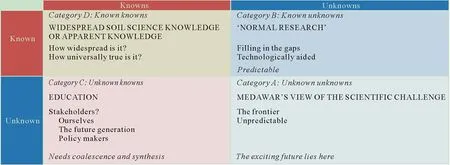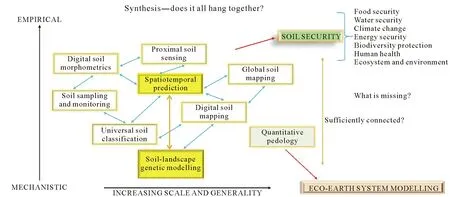Developing the new soil science-Advice for early-career soil scientists
Confucius said,“To know what you know and what you do not know,that is true knowledge.”
Hartemink(2006)edited a prescient book on the future of soil science,the contents of which are worthy of consideration today.Since then,there has been a growing emphasis on soil carbon,soil health,and soil security,as well as increased capability of technology related to machine leaning and soil sensing and measurement.
SOIL KNOWLEDGE DISCOVERY CATEGORISATION
Based on the above ancient aphorism attributed to Confucius,the author writing in Hartemink(2006)classified soil knowledge and knowledge discovery into 4 categories.An updated version is given in Fig.1.

Fig.1 A categorisation of soil knowledge discovery.
CategoryD(the known knowns).This is the canon of soil science that all professional soil scientists know.Now,and in the future,we have to consider all this and test it for inconsistencies and erroneous concepts.Here are two possible examples.Is it time for new concepts?Is it time for Jenny’s factorial approach to be superseded?Some advocate an energy-mass balance approach.Is the concept of soil health deceptive or just too narrow and limited?We should expend about 5%of our total research effort in this category.
CategoryC(the unknown knowns).This is clearly about education-the task of making others aware of what we know and what we can do.First,we need to coalesce and synthesise our knowledge-make it less piecemeal-and then disseminate it to our fellow scientists,the new generations,policy makers,and the public.This is a big task given that in many countries the newer generations and the governments seem to have become less enchanted with science.Machine learning and artificial intelligence have a place here-we need to understand what that place is.We need to expend about 40%of our effort here.
Category B(the known unknowns).This is what most people think of as research.It is about colouring in a blackand-white picture,or putting flesh on the bones,of our knowledge.Among the many known unknowns we know,we need a thorough understanding of soil biological function,the discovery of the real structure and function of soil organic matter,a quantitative theory of soil variation,and a way to successfully spatially and temporally aggregate and disaggregate soil properties and processes.Technology,facilitating new measuring machines and instruments,is a great aid here,but it should not drive the agenda.Technology is there to help us answer the questions,not to be an end in itself.About 50%of our effort needs to be placed into this,but it should not be much more than that.
Category A(the unknown unknowns).Some consider this to be the real science and real research.Very few people work here,out on the edge,anymore.Governments and institutions do not understand this place-it is too speculative and theoretical.It is difficult to get money to do this,but then perhaps it does not need money-it requires understanding and imagination.We need time,and a lot of it,because it requires deep thought.This is where the breakthroughs occur.The new ideas here will give the researchers of Category B something to do for 30 years or more after these advances have been made.Logically,I am unable to tell you what they will be,but they could be unusual ideas such as bacteria producing clay minerals or soil thickness being the key control of terrestrial ecosystems.We need to spend much more time thinking,and we need to devote at least 5%of our effort here.
For soil science to advance,we need our early-career researchers(ECRs)to be aware of these categories,to be aware of the categories in which they are operating and the key questions within each category,and to be able to consider the future.The future is ours to create,and logically the early-career scientists probably contribute more to that future than the more experienced.
MAPPING ONE’S OWN RESEARCH AREAS
In addition to understanding the categorization of knowledge,it is instructive to know where one’s own research lies in relation to that of others.This can be achieved by asking two self-reflective questions:Can you place what you are doing with that which others are doing,in related areas of soil science and beyond?Can you construct a picture of how it all fits together?
How can these questions be answered?Perhaps the simplest way is to make a mental map.One of the best ways to do this is to define two axes.These axes could be the nature of the research and the scale of application,but of course other axes may be relevant depending on the area of research.By way of example,Fig.2 maps out the soil discovery space in which the author works largely.

Fig.2 Soil discovery space in which the author operates.Most of the work is Category B(from Fig.1),but not exclusively so.Arrows show linkages between discovery topics.This highlights where topics and linkages are missing and connections are weak,suggesting areas for improvement.
In the author’s case,the chosen abscissa is the‘scale and generality’,going from fine resolution and extent and coarser resolution and extent-from the inter-aggregate scale-to the globe.The ordinate represents‘the continuum’between purely mechanistic modelling and purely empirical modelling.Various topics which the author has developed or investigated have been placed onto the space.This leads to the following questions.Do they fit together?Is there anything missing?The arrows represent the links between topics.It is clear that the link between spatiotemporal prediction and soil-landscape genetic modelling is virtually non-existent,and perhaps a subject area we might call quantitative pedology needs to be placed in the diagram.The author sees the whole diagram as the space of pedometrics.Of course,this is not the whole of soil science,just a part of it.Most of us work in some part of the soil science space.It is interesting and revealing to discover how large or small that space is and how it relates to others.
Early-career soil scientists are our future.The author encourages our ECRs to construct a similar diagram for their area of work,discuss it with their colleagues,and try to coalesce it with diagrams from those colleagues.Building up the picture will reveal the whole soil discovery space.Missing areas will emerge suggesting new lines of enquiry and new links to be established.Such synthesis and‘joining up’will take and drive everyone’s science further and longer and will strengthen soil science and soil understanding enormously.Powerful synthesis will lead to a much deeper soil science.
- Pedosphere的其它文章
- Biophotoelectrochemistry:An emerging frontier for channeling photoelectric effect into darkness zone of soils and sediments
- Balancing machine learning and artificial intelligence in soil science with human perspective and experience
- Soils in extraterrestrial space:Need for studies under microgravity
- Role of biochar in raising blue carbon stock capacity of salt marshes
- Long-term fertilizer nitrogen management-Soil health conundrum
- Partnering crops with root-associated microbes for soil health and agricultural sustainability

